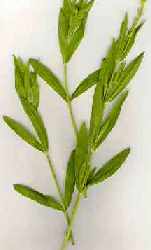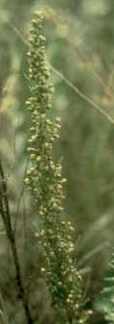Categories
Calendars
Guides
Reviews
Archive
Gallery
Articles
Ask Our Gardening Expert
Growing Tarragon
Tarragon Tarragon has few medicinal uses, but does have the peculiar property of
causing slight numbness of the mouth when the leaves are chewed. It is an aromatic perennial that is native to
Siberia and the Caspian sea area. Tarragon enhances the flavour of many foods, but can become overpowering
if used excessively It goes well with fish, pork, beef, poultry, game, potatoes, tomatoes, carrots, and most mainstream
vegetables. It also goes well with lemons and oranges.
Tarragon can be used in cream sauces, herbed butters and vinegars,
soups, sour creams, and yogurt.
TARRAGON Tarragon Folklore Latin Name Type Site and Soil Plant to Harvest Time
Where To Grow Tarragon
French
tarragon cannot be grown from seed as it reverts back to the
Russian tarragon, so it needs to be propagated from cuttings. If you are
growing tarragon from seed therefore your only choice is Russian
tarragon. This is a pity because French tarragon has a superior flavour.
If you want to grow French tarragon, buy a small plant from your local
nursery. Planting and Care of Tarragon Plant as normal, ensuring that they are watered if the conditions are dry.
Choose a position where they can remain undisturbed for two or three
years. Tarragon is not a particularly attractive plant, so consider this
when choosing a position. Mulching with organic matter in
October
will
help them over winter if your area has particularly harsh winter
weather. Container Growing Tarragon Harvesting Tarragon END OF TARRAGON ARTICLE
This herb has a peppery flavour with a slight hint of vinegar that is suited to vinegars and
fish, but it also has many other uses in the kitchen. It is
originally from southern Russia and western Asia.
QUICK GUIDE
Click here
Artemesia dracunculus
Edible perennial herb
Well drained soil, in sun or partial shade.
10 weeks
Tarragon prefers well-drained soil which is not too high in
nutrients. It will do equally well in full sun or partial shade.
Propagating Tarragon
 Start
the seeds off in pots around
April time. Sow four or five seeds per pot
in moist potting compost covering them with compost to exclude light.
Keep them indoors at room temperature. When the seedlings begin to show,
move them outside, out of direct sunlight. Thin them to one seedling per
pot. They are ready for planting in their final position outside when
the seedlings are 10cm (4in) high.
Start
the seeds off in pots around
April time. Sow four or five seeds per pot
in moist potting compost covering them with compost to exclude light.
Keep them indoors at room temperature. When the seedlings begin to show,
move them outside, out of direct sunlight. Thin them to one seedling per
pot. They are ready for planting in their final position outside when
the seedlings are 10cm (4in) high.
Dig the soil well before planting and add a handful of bonemeal per
square metre (yard) at the same time. If the soil is not well-drained
dig in as much well-rotted organic material as possible to open up the
soil - alternatively obtain a small amount of sharp sand from your
garden centre and dig that well into the soil. Tarragon
has a very vigorous root system and the plants will begin to decline
after three years or so as the roots begin to 'strangle themselves. In
the autumn of the third year it is possible to dig up the plants, divide
them and replant, however they do not really appreciate this treatment.
It is best to throw them on the compost heap and start with new seeds
next Spring
Tarragon
has a very vigorous root system and the plants will begin to decline
after three years or so as the roots begin to 'strangle themselves. In
the autumn of the third year it is possible to dig up the plants, divide
them and replant, however they do not really appreciate this treatment.
It is best to throw them on the compost heap and start with new seeds
next Spring
Tarragon can be grown in containers for two or three years with no
special care - water and liquid feed a little less than normal. They can
also be over-wintered indoors if you have a sunny windowsill, but as
mentioned above they are not attractive plants. One plant should be
enough for a normal household's requirements.
Best used fresh or from frozen, just snip off a piece whenever
needed. If you want to freeze a lot of tarragon, the best time to
harvest it is in
July
or early
August
.